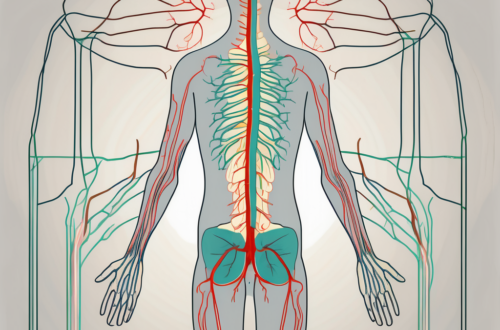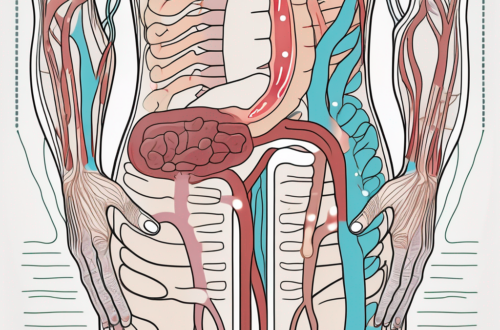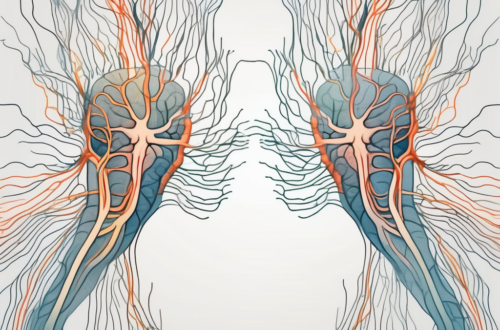The human body is a complex system comprised of various interconnected networks that work together to maintain homeostasis and ensure optimal functioning. One such network is the autonomic nervous system, which controls the involuntary functions of the body. Within the autonomic nervous system, there are two branches: the sympathetic and parasympathetic systems. This comprehensive guide aims to provide a thorough understanding of the parasympathetic nerve pathways and their significance in maintaining bodily functions.
Introduction to the Autonomic Nervous System
The autonomic nervous system (ANS) is a complex network of nerves that plays a vital role in regulating various bodily functions. It operates unconsciously, allowing the body to respond automatically to different stimuli without our conscious control. The ANS is responsible for maintaining the internal environment of the body, ensuring stability and adaptability to changes in both external and internal factors.
Imagine a symphony orchestra, where each instrument plays a unique part to create a harmonious melody. Similarly, the ANS orchestrates the different organs, glands, and smooth muscles in our body to maintain homeostasis and enable us to respond appropriately to different situations.
The Role and Importance of the Autonomic Nervous System
The autonomic nervous system plays a crucial role in our overall well-being by regulating essential bodily functions that occur without our conscious control. It acts as the conductor of our internal symphony, ensuring that each instrument plays its part in perfect harmony.
One of the primary functions of the ANS is to regulate heart rate, ensuring that it beats at an appropriate rate to meet the body’s demands. Whether we are resting or engaging in physical activity, the ANS adjusts the heart rate accordingly, maintaining a delicate balance.
In addition to heart rate regulation, the ANS also controls digestion, allowing us to break down and absorb nutrients from the food we consume. It coordinates the movement of our digestive tract, ensuring that food is propelled through the system efficiently. Without the ANS, our digestive process would be disrupted, leading to various gastrointestinal issues.
Furthermore, the ANS regulates respiration, ensuring that we receive enough oxygen and expel carbon dioxide. It controls the muscles involved in breathing, adjusting their activity based on our body’s needs. This automatic regulation allows us to focus on other tasks without consciously thinking about our breathing.
Distinguishing Between Sympathetic and Parasympathetic Systems
Within the autonomic nervous system, there are two main branches: the sympathetic and parasympathetic systems. These branches often have opposing effects on bodily functions, creating a delicate balance that allows us to adapt to different situations.
The sympathetic system is responsible for the body’s “fight-or-flight” response. When faced with a perceived threat or danger, this branch of the ANS prepares the body for action. It increases heart rate, dilates the airways, and redirects blood flow to the muscles, enabling us to respond quickly and effectively.
On the other hand, the parasympathetic system promotes a “rest-and-digest” state. It conserves energy and facilitates relaxation. When we are in a calm and safe environment, the parasympathetic system takes over, slowing down heart rate, constricting the airways, and redirecting blood flow to the digestive system, allowing us to rest and recover.
These two branches of the autonomic nervous system work together like a seesaw, constantly adjusting and balancing each other to maintain equilibrium. They ensure that our bodily functions are appropriately regulated, allowing us to navigate through the complexities of life.
Detailed Overview of Parasympathetic Nerve Pathways
The parasympathetic nerve pathways are a crucial component of the autonomic nervous system. They originate from specific regions of the central nervous system and extend to various organs and tissues throughout the body, exerting control over their functions.
The parasympathetic nervous system is often referred to as the “rest and digest” system, as it is responsible for promoting relaxation and facilitating digestion. It works in opposition to the sympathetic nervous system, which is responsible for the body’s “fight or flight” response.
Anatomy of Parasympathetic Nerve Pathways
The parasympathetic nerve pathways consist of several cranial nerves, such as the oculomotor, facial, glossopharyngeal, and vagus nerves. These nerves carry signals from the central nervous system to specific organs and tissues, allowing for precise regulation of their activities.
The oculomotor nerve, for example, controls the constriction of the pupil and the accommodation of the lens for near vision. The facial nerve innervates the salivary glands, promoting the production of saliva, which aids in the digestion of food. The glossopharyngeal nerve plays a role in swallowing and taste sensation, while the vagus nerve is responsible for regulating heart rate, gastrointestinal motility, and respiratory function.
Functions of Parasympathetic Nerve Pathways
The parasympathetic nerve pathways are responsible for regulating several vital bodily functions. They play a crucial role in promoting rest and relaxation, stimulating digestion, slowing heart rate, and facilitating various other processes necessary for the body’s well-being.
When the parasympathetic nervous system is activated, it causes the release of acetylcholine, a neurotransmitter that slows down heart rate, increases intestinal and glandular activity, and promotes the relaxation of smooth muscles. This allows for efficient digestion and absorption of nutrients, as well as the elimination of waste products.
Furthermore, the parasympathetic nervous system is involved in maintaining homeostasis by regulating blood pressure, body temperature, and respiratory rate. It also plays a role in sexual arousal and reproduction, as it controls the release of reproductive hormones and facilitates the necessary physiological responses.
In addition to its direct effects on organs and tissues, the parasympathetic nervous system also interacts with other systems in the body. It communicates with the endocrine system, influencing the release of hormones, and with the immune system, modulating immune responses. This intricate network of interactions ensures the overall balance and well-being of the body.
The Neurotransmitters Involved in Parasympathetic Nerve Pathways
The proper functioning of parasympathetic nerve pathways relies on a complex interplay of neurotransmitters. These chemical messengers transmit signals between nerve cells, allowing for effective communication within the parasympathetic system.
The parasympathetic nervous system, often referred to as the “rest and digest” system, is responsible for promoting relaxation and maintaining homeostasis in the body. It counterbalances the sympathetic nervous system, which is responsible for the “fight or flight” response.
Acetylcholine, a neurotransmitter that plays a crucial role in the parasympathetic nervous system, is released from nerve endings and binds to receptors on target cells, initiating a response. It is considered the primary neurotransmitter involved in parasympathetic nerve pathways.
Acetylcholine: The Primary Neurotransmitter
Acetylcholine acts as a chemical messenger that transmits signals across synapses, the junctions between nerve cells. It is synthesized from choline and acetyl coenzyme A in nerve cells and is then packaged into vesicles, ready to be released upon stimulation.
Once released, acetylcholine binds to specific receptors on target cells, triggering a cascade of events. In the parasympathetic nervous system, acetylcholine promotes relaxation and helps regulate various bodily functions.
One of the key roles of acetylcholine in the parasympathetic system is the stimulation of digestion. It acts on smooth muscle cells in the gastrointestinal tract, promoting peristalsis, the rhythmic contractions that propel food through the digestive system. Acetylcholine also stimulates the secretion of digestive enzymes and increases blood flow to the digestive organs, optimizing nutrient absorption.
In addition to its digestive functions, acetylcholine plays a vital role in regulating heart rate. It acts on the sinoatrial (SA) node, the natural pacemaker of the heart, slowing down the heart rate and promoting a state of relaxation.
Furthermore, acetylcholine is involved in the regulation of various glands, including the salivary glands, lacrimal glands (tear production), and bronchial glands. It stimulates the secretion of saliva, tears, and mucus, aiding in the lubrication and protection of these tissues.
Overall, acetylcholine is essential for maintaining the balance and proper functioning of the parasympathetic nervous system, ensuring optimal physiological processes.
Role of Other Neurotransmitters
In addition to acetylcholine, other neurotransmitters also play a role in parasympathetic functions. While their specific functions are still being explored, they contribute to the regulation of certain parasympathetic pathways.
Nitric oxide, for example, acts as a vasodilator, enhancing blood flow to specific tissues. It helps regulate blood pressure and plays a role in various physiological processes, including penile erection and gastrointestinal motility.
GABA (gamma-aminobutyric acid), serotonin, and dopamine are neurotransmitters that have been found to have some involvement in the parasympathetic nervous system. GABA is an inhibitory neurotransmitter that helps reduce neuronal excitability, promoting relaxation. Serotonin, often referred to as the “happy hormone,” is involved in mood regulation and has been linked to the parasympathetic control of gastrointestinal functions. Dopamine, known for its role in the reward system, has also been found to influence parasympathetic pathways, although its exact mechanisms are still being studied.
Understanding the intricate interplay of these neurotransmitters and their functions in the parasympathetic nervous system is an ongoing area of research. Further exploration of their roles may provide insights into potential therapeutic targets for various disorders and conditions related to parasympathetic dysfunction.
Impact of Parasympathetic Nerve Pathways on Bodily Functions
The parasympathetic nerve pathways exert a significant impact on various bodily functions, facilitating normal functioning and contributing to overall well-being.
The parasympathetic system, also known as the “rest and digest” system, is responsible for promoting relaxation and restoring the body to a state of balance after periods of stress or activity. It works in opposition to the sympathetic nervous system, which is responsible for the body’s “fight or flight” response.
Parasympathetic Nerve Pathways and Digestion
One of the prominent roles of the parasympathetic system is its involvement in digestion. When the body is in a relaxed state, the parasympathetic pathway stimulates the release of digestive enzymes, increases intestinal motility, and enhances nutrient absorption. This optimizes the digestive process, ensuring efficient breakdown and assimilation of nutrients.
Furthermore, the parasympathetic system promotes the secretion of saliva, which contains enzymes that begin the process of breaking down carbohydrates. This not only aids in digestion but also enhances the taste and enjoyment of food.
Influence on Heart Rate and Breathing
The parasympathetic system also plays a vital role in regulating heart rate and respiration. Through its nerve pathways, it helps to lower heart rate, promoting a state of calmness and decreasing the workload on the heart. This is particularly beneficial during periods of rest and relaxation, allowing the heart to conserve energy and maintain optimal functioning.
In addition to heart rate regulation, the parasympathetic system also influences breathing. It promotes slow and deep breaths, which can help to reduce anxiety, increase oxygenation of the blood, and promote a sense of tranquility.
Impact on Eye Function
The parasympathetic nerve pathways also affect the function of the eyes. These pathways control the muscles that govern the constriction of the pupils and the ability to focus. By regulating these functions, the parasympathetic system allows for optimal visual acuity and adaptability to different lighting conditions.
Moreover, the parasympathetic system is responsible for the production of tears, which help to keep the eyes lubricated and protect them from dryness and irritation. Tears also contain enzymes and antibodies that help to prevent infections and maintain the health of the eyes.
In conclusion, the parasympathetic nerve pathways play a crucial role in maintaining various bodily functions. From digestion to heart rate regulation and eye function, these pathways ensure that the body operates optimally, promoting overall well-being and contributing to a state of balance and relaxation.
Disorders Related to Parasympathetic Nerve Pathways
As with any complex system, disruptions in the parasympathetic nerve pathways can lead to various disorders that impact bodily functions. The parasympathetic nervous system is responsible for regulating many essential bodily functions, including digestion, heart rate, and glandular activity. When these pathways are disrupted, it can result in a range of symptoms and conditions.
Understanding the signs and symptoms of disorders related to the parasympathetic system is crucial for seeking appropriate medical attention. By recognizing these symptoms, individuals can work with healthcare professionals to obtain an accurate diagnosis and develop an effective treatment plan.
Common Disorders and Their Symptoms
Disorders affecting the parasympathetic system can manifest in different ways, depending on the specific pathways that are disrupted. One example is dysautonomia, a condition characterized by dysfunction of the autonomic nervous system. Dysautonomia may present with symptoms such as dizziness, lightheadedness, abnormal heart rate variability, and difficulty regulating body temperature.
Another disorder related to the parasympathetic system is gastroparesis, which affects the normal movement of food through the digestive tract. Symptoms of gastroparesis can include bloating, nausea, vomiting, early satiety, and delayed gastric emptying. Individuals with this condition may experience difficulty in digesting food and may require dietary modifications to manage their symptoms.
In addition to dysautonomia and gastroparesis, there are other disorders that can affect the parasympathetic system. These include neurogenic bladder, where the nerves controlling bladder function are impaired, resulting in urinary retention or incontinence. Another example is dry eye syndrome, which occurs when the parasympathetic nerves responsible for tear production are disrupted, leading to dryness, irritation, and vision problems.
Diagnosis and Treatment Options
Diagnosing disorders related to parasympathetic nerve pathways often requires a comprehensive evaluation by a healthcare professional. This may involve a thorough medical history, physical examination, and specialized tests. The healthcare provider will assess the individual’s symptoms, perform relevant diagnostic tests, and consider other factors such as medical history and family history.
Treatment options for disorders affecting the parasympathetic system vary depending on the specific disorder and its underlying cause. In some cases, lifestyle modifications may be recommended, such as dietary changes, stress management techniques, and regular exercise. Medications may also be prescribed to manage symptoms and improve overall functioning of the parasympathetic system.
In certain situations, targeted interventions may be necessary. For example, individuals with neurogenic bladder may require catheterization or other methods to empty the bladder. Those with dry eye syndrome may benefit from artificial tears, medications to stimulate tear production, or procedures to block tear drainage.
It is crucial to consult with a healthcare provider for a proper diagnosis and individualized treatment plan. They can provide guidance and support in managing the symptoms and improving the overall quality of life for individuals with disorders related to parasympathetic nerve pathways.
Future Research Directions in Parasympathetic Nervous System
Advances in scientific research continue to shed light on the intricate workings of the parasympathetic nervous system. Ongoing studies explore several areas of interest, seeking to advance our understanding of this crucial component of the autonomic nervous system.
Current Challenges in the Field
Despite significant progress, researchers still face challenges in fully elucidating the complexities of the parasympathetic system. The precise interactions between various cell types, neurotransmitters, and receptors require further investigation to unravel the mechanisms underlying parasympathetic regulation.
Potential Breakthroughs and Innovations
Emerging technologies and evolving research methodologies provide promising avenues for future breakthroughs in parasympathetic nervous system studies. Combined with advancements in molecular biology and targeted therapeutic interventions, these innovations may lead to improved treatments for disorders affecting parasympathetic functions.
Conclusion: The Significance of Parasympathetic Nerve Pathways
Understanding the intricacies of the parasympathetic nerve pathways is critical for comprehending the regulation of vital bodily functions. Through its control over digestion, heart rate, breathing, and various other processes, the parasympathetic system plays a fundamental role in maintaining overall well-being.
Recap of Key Points
– The autonomic nervous system regulates involuntary bodily functions.
– The sympathetic and parasympathetic systems are two distinct branches of the autonomic nervous system.
– The parasympathetic nerve pathways promote rest and relaxation and regulate digestion, heart rate, and eye function.
– Acetylcholine is the primary neurotransmitter involved in parasympathetic nerve pathways.
– Disorders related to the parasympathetic system can impact digestion, heart rate, and other bodily functions.
– Continued research in the field aims to further advance our understanding and improve treatments for disorders affecting parasympathetic functions.
The Importance of Continued Research
Research in the field of parasympathetic nervous system functioning is crucial to gaining a deeper understanding of its complexities. By exploring the intricate connections and interactions within this system, researchers can pave the way for innovative therapies that optimize the functioning of the parasympathetic pathways, enhancing overall health and quality of life. As with any health concern, it is advisable to consult with a healthcare professional for personalized guidance and medical advice.





